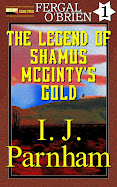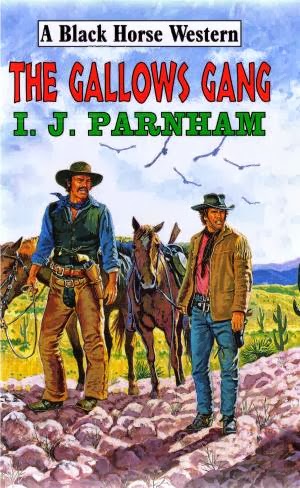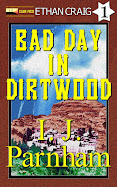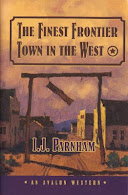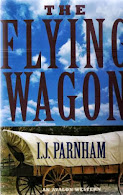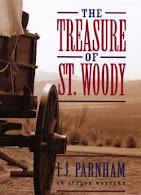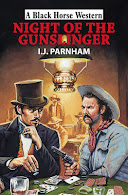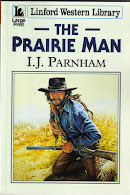Monday 29 April 2013
Review of Night of the Gunslinger
I’ve always enjoyed stories that take place over a short period of time, and here Ian Parnham does just that; with everything happening during one night...
Read more at Western Fiction Review
Wednesday 24 April 2013
Night of the Gunslinger
I received my complimentary copies of Night of the Gunslinger today and I like the cover. The picture is set at night and as an incident at the poker table is a crucial part of the story, it feels appropriate.
The story was an itch I had to scratch. I'd tried several times to write a story set during a single day, but every time the plot contrivances grew and I abandoned the principle. With this novel I'd originally started the story at sundown on the night before a man's trial for murder. I didn't know if he was innocent or guilty, but I hoped to find out as I went along.
As it turned out, I wrote and wrote without any sign of the trial getting started until I realized I'd written eight chapters and it was still dark. Without trying I was accidentally doing the thing I'd tried to do before of writing a story in almost real time. So I carried on and as it turned out, everything came together before sun-up letting me finally itch the itch...
It's my 27th Black Horse Western and the book is now available.
With the town marshal laid up with a broken leg, Deputy Rick Cody must stand alone to protect New Town during a night of mayhem. At sunup Edison Dent will stand trial for Ogden Reed's murder and although Rick suspects that Edison is innocent, he also reckons his own sister knows more than she's prepared to reveal.
With Rick having only one night to uncover the truth, his task is made harder when the outlaw Hedley Beecher plots to free the prisoner while Ogden's brother Logan vows to kill Edison and anyone who stands in his way.
Within an hour of sundown four men are dead. And so begins the longest and bloodiest night of Rick's life...
The story was an itch I had to scratch. I'd tried several times to write a story set during a single day, but every time the plot contrivances grew and I abandoned the principle. With this novel I'd originally started the story at sundown on the night before a man's trial for murder. I didn't know if he was innocent or guilty, but I hoped to find out as I went along.
As it turned out, I wrote and wrote without any sign of the trial getting started until I realized I'd written eight chapters and it was still dark. Without trying I was accidentally doing the thing I'd tried to do before of writing a story in almost real time. So I carried on and as it turned out, everything came together before sun-up letting me finally itch the itch...
It's my 27th Black Horse Western and the book is now available.
With the town marshal laid up with a broken leg, Deputy Rick Cody must stand alone to protect New Town during a night of mayhem. At sunup Edison Dent will stand trial for Ogden Reed's murder and although Rick suspects that Edison is innocent, he also reckons his own sister knows more than she's prepared to reveal.
With Rick having only one night to uncover the truth, his task is made harder when the outlaw Hedley Beecher plots to free the prisoner while Ogden's brother Logan vows to kill Edison and anyone who stands in his way.
Within an hour of sundown four men are dead. And so begins the longest and bloodiest night of Rick's life...
Wednesday 17 April 2013
Today is a good day to rediscover Star Trek: Enterprise - Part 1
I've just finished watching the last and, in the opinion of the handful of fans who've watched it, the least Star Trek spin-off tv series. Having watched Enterprise in its entirety for the first time I think it's time the series got some of the credit it's never been accorded. Even today in the world of Trekkie fandom, there appears to be only two subject matters on which many fans can agree: that JJ Abrams couldn’t give a stuff about Trek, and that Enterprise was rubbish.
I can't get excited about debating the first subject and in truth I used to agree with the second one. When Enterprise started in 2001, I'd watched over 500 episodes of the franchise during its 14 years of being continually on air, and that's enough crinkly-headed aliens, malfunctioning holodecks and temporal disturbances in the duotronic tachyon matrix for anyone. It wasn't helped that in the UK it aired on Channel 4 as part of the T4 schedule, which caters for gormless teenagers. So every week I had to sit through the single most annoying and smug human in history June Sarpong interviewing boybands before getting my weekly dose of space nonsense.
I watched most of season 1, started to drift away in season 2 and when the Xindi arrived in season 3, I checked out for good. A break of ten years has helped me to see past those irritations and I now reckon the series holds together better than I expected. It's not a masterpiece and it makes mistakes, but then again so do the other Trek spin-offs. Next Generation opens with two dire seasons and closes badly. Deep Space 9 has several dodgy years until Sisko shaves his head and Voyager plumbs the depths in the early years with Kes and Neelix and the Kazon. Enterprise on the other hand presents four solid seasons of entertainment and it has glossy production values and modern story telling techniques that have yet to date. So over two articles I'd like to address the balance and heap some praise on the most maligned of the Trek spin-offs.
Season 1
The series starts promisingly with Broken Bow, probably the best Trek pilot show. It doesn't have The Cage's goofiness, Farpoint Station's ponderous nature, Emissary's filler scenes, or Caretaker's poor use of the Prime Directive. Instead, it provides a lively story and situation that feels as if it is set somewhere between now and Kirk's era. People wear suits and ties and get excited about space travel. Enterprise is cramped and functional. Technology is limited. Transporters are untried, there are no universal translators and there's definitely no holodeck.
Aliens are also in short supply with the Vulcans being portrayed as arrogant and the Klingons as murderous thugs. The only weak note is that the new alien race of the Suliban are uninteresting, which sadly sets a precedent for the show in which all the new aliens are dull. The story gets the balance right for a pilot with the characters being introduced by the way they react to the plot and the plot itself about returning a Klingon to his home world is a strong piece of space adventure featuring numerous set pieces. The Suliban space station built out of thousands of small ships and the ice-bound frontier town both feel like places Trek has never visited before.
After all the excitement in the pilot, it's strange that once the series gets going, individual episodes turn out to be quiet character pieces. One of the strengths of the Trek format was to remove the science from the science fiction so that it could concentrate on the stories. For example the transporter took the characters from the spaceship to an alien planet in a moment freeing up the time taken in getting from A to B. Enterprise turns this on its head and makes stories out of the fact that the technology isn’t available. So alien ships have to be boarded with shuttlecrafts and spacesuits, alien dialogue needs to be translated, and with a maximum speed of warp 5 it takes time to get places.
With the technology being a struggle the show depicts how the characters react to being in space, with some of the crew being wary and others treating the mission as a holiday with a chance to visit alien bars, meet alien women, and make snowmen on comets. Most pleasing of all is the show's colour palette and design. Trek had increasingly become about bright lights and day-glo costumes, but Enterprise is more in keeping with modern science fiction with its grime and darkness. The predominant colours are dirty grey and dirty brown. Every alien ship they meet looks like a cargo ship with rust and oil on the walls. Doors need to be dragged open while to operate anything, levers must be pulled and cogs have to be cranked.
The small scale stories of season 1 are an interesting change to the usual plot heavy Trek stories, but it highlights a problem that plagues the show, namely the uneven balance of time devoted to the characters. I assume the show tried to recreate the three-part act of Kirk, Spock and McCoy with the rest being secondary support, and it almost works. Scott Bakula with his cheesy acting style is for me the perfect actor to play a Starfleet captain. Nobody else could deliver lines like, 'You just don’t know how much I want to knock you down on your ass right now.' and not make you groan. Archer's sidekick Trip, played as an cheerful Chief O'Brien is always watchable, but the third part of the group T'Pol was a bad idea. The thinking behind the character is obvious. Leeta's breasts livened up later seasons of Deep Space 9 while Seven of Nine's breasts were so big they saved Voyager from cancellation. So all Enterprise needed for a great character is even bigger breasts, but sadly the makers forgot that Leeta was a lot of fun and Seven was a compelling character, whereas T'Pol is so quiet and disinterested in everything, she makes every scene she's in drag.
The rest of the cast rarely get the chance to shine. Phlox could have been a great Trek doctor, being an optimistic opposite of Voyager's misanthropic Doctor. His early line of: 'There's a chance he could live, just not a good one.' shows so much potential, but it's never realized. Linguist Hoshi is scared of her own shadow and so is a much-needed antidote to all those fearless Trek officers, except the writers rapidly tired of her being scared all the time and so she only gets to be nervous when the script calls for it. Security officer Reed is such a mystery the first story in which he gets more than one line involves the cast trying to work out why he's so mysterious, and then finding out his big secret is he likes pineapple. The actor should have stayed in the sitcom Desmond's as he got more to do there. The last main character is of course Enterprise's big joke, except it was done better in Galaxy Quest when they had a character whose name nobody could remember. Archer's dog Porthos gets more screen time than poor old Ensign Mayweather, and once you notice the scripts go out of their way to avoid having him do anything, you're left to wonder why he's even there, which he usually isn’t.
Highlights: The episode Doctor, Doctor where the crew help aliens for noble reasons, but then discover their intervention is harming their natural development. Exploring the need for a Prime Directive is the perfect subject for a prequel and this story does it well. Also strong is the developing arc involving friction between the Vulcans and the Andorians, which introduces Jeffrey Combs' recurring character Shran. My favourite individual moment is an episode where Enterprise blasts off a torpedo only to watch it bounce off the alien's spaceship without making a scratch, leaving the crew to just sit there and hope they don’t get killed in retaliation. This scene perfectly depicts Enterprise's lowly role in galactic affairs.
Lowlights: The temporal cold war arc, which is the lamest time-travel idea in all Trek. It's obviously being made up as they go along, so it’s impossible to care about any of it. The worst moment of the year is the Decontamination chamber, in fact it's probably the worst moment in all Trek, evicting the two previous candidates of Paris and Janeway turning into lizards and mating, and Spock jamming with groovy hippy alien chicks. The Decontamination chamber is something you watch assuming it's an ironic joke, except it's not and once you've seen it you can never unwatch it. Here's a clip. You have been warned.
Season 2
The most noticeable thing about season 1 is there are no dreadful episodes and I reckon it can be classed as the best first season of any of the Trek spin-offs. But sadly, season 1's low-key, low-tech, low-action approach to space stories didn’t appeal to viewers and so what would become an annual rethink leads to season 2 increasing the amount of action. So Reed invents red alert leading to everyone running around with phasers instead of interacting.
This new sense of urgency works well for a while. One excellent early development has the ship taking heavy damage in one episode only for the next week's episode to start with the damage still unrepaired, which leads to a story about searching for raw materials. After seven years of Voyager and its reset button attitude to ship repairs, this was an excellent note of realism. But the early promise soon fades away and mid-season 2 presents the worst of Enterprise with the temporal cold war blundering along and the promising Andorian arc stalling.
With the show drifting along aimlessly failing to build on its potential while retelling stories that have all been done before and better, it looked as if the show would be cancelled. So all thoughts turned to re-inventing the format, which I have mixed feelings about as just before the big change, Enterprise unexpectedly comes into focus and season 2 ends with a strong series of episodes. Cogenitor, which deals with a disastrous cultural misunderstanding, should be acclaimed as one of Trek's finest ever episodes, while The Breach highlights Phlox's strengths. Judgement pays homage to The Undiscovered Country with a visit to a famous Klingon prison and the Borg episode is better than Voyager's Borg episodes and the later Next Generation ones too.
Highlight: The annual Hoshi being drippy episode.
Lowlight: The episode where Trip falls in love with an annoying princess, who is played by the single most wooden actor I've ever seen in anything. Oh and the one where Porthos is the central character.
Pondering on what does and doesn’t work in season 2 rapidly becomes irrelevant as with the final episode of the year, everything changes with the show moving from an episodic format to becoming a serial. So in a couple of weeks I'll look at the second half of Enterprise, the good part.
I can't get excited about debating the first subject and in truth I used to agree with the second one. When Enterprise started in 2001, I'd watched over 500 episodes of the franchise during its 14 years of being continually on air, and that's enough crinkly-headed aliens, malfunctioning holodecks and temporal disturbances in the duotronic tachyon matrix for anyone. It wasn't helped that in the UK it aired on Channel 4 as part of the T4 schedule, which caters for gormless teenagers. So every week I had to sit through the single most annoying and smug human in history June Sarpong interviewing boybands before getting my weekly dose of space nonsense.
I watched most of season 1, started to drift away in season 2 and when the Xindi arrived in season 3, I checked out for good. A break of ten years has helped me to see past those irritations and I now reckon the series holds together better than I expected. It's not a masterpiece and it makes mistakes, but then again so do the other Trek spin-offs. Next Generation opens with two dire seasons and closes badly. Deep Space 9 has several dodgy years until Sisko shaves his head and Voyager plumbs the depths in the early years with Kes and Neelix and the Kazon. Enterprise on the other hand presents four solid seasons of entertainment and it has glossy production values and modern story telling techniques that have yet to date. So over two articles I'd like to address the balance and heap some praise on the most maligned of the Trek spin-offs.
Season 1
The series starts promisingly with Broken Bow, probably the best Trek pilot show. It doesn't have The Cage's goofiness, Farpoint Station's ponderous nature, Emissary's filler scenes, or Caretaker's poor use of the Prime Directive. Instead, it provides a lively story and situation that feels as if it is set somewhere between now and Kirk's era. People wear suits and ties and get excited about space travel. Enterprise is cramped and functional. Technology is limited. Transporters are untried, there are no universal translators and there's definitely no holodeck.
Aliens are also in short supply with the Vulcans being portrayed as arrogant and the Klingons as murderous thugs. The only weak note is that the new alien race of the Suliban are uninteresting, which sadly sets a precedent for the show in which all the new aliens are dull. The story gets the balance right for a pilot with the characters being introduced by the way they react to the plot and the plot itself about returning a Klingon to his home world is a strong piece of space adventure featuring numerous set pieces. The Suliban space station built out of thousands of small ships and the ice-bound frontier town both feel like places Trek has never visited before.
After all the excitement in the pilot, it's strange that once the series gets going, individual episodes turn out to be quiet character pieces. One of the strengths of the Trek format was to remove the science from the science fiction so that it could concentrate on the stories. For example the transporter took the characters from the spaceship to an alien planet in a moment freeing up the time taken in getting from A to B. Enterprise turns this on its head and makes stories out of the fact that the technology isn’t available. So alien ships have to be boarded with shuttlecrafts and spacesuits, alien dialogue needs to be translated, and with a maximum speed of warp 5 it takes time to get places.
With the technology being a struggle the show depicts how the characters react to being in space, with some of the crew being wary and others treating the mission as a holiday with a chance to visit alien bars, meet alien women, and make snowmen on comets. Most pleasing of all is the show's colour palette and design. Trek had increasingly become about bright lights and day-glo costumes, but Enterprise is more in keeping with modern science fiction with its grime and darkness. The predominant colours are dirty grey and dirty brown. Every alien ship they meet looks like a cargo ship with rust and oil on the walls. Doors need to be dragged open while to operate anything, levers must be pulled and cogs have to be cranked.
The small scale stories of season 1 are an interesting change to the usual plot heavy Trek stories, but it highlights a problem that plagues the show, namely the uneven balance of time devoted to the characters. I assume the show tried to recreate the three-part act of Kirk, Spock and McCoy with the rest being secondary support, and it almost works. Scott Bakula with his cheesy acting style is for me the perfect actor to play a Starfleet captain. Nobody else could deliver lines like, 'You just don’t know how much I want to knock you down on your ass right now.' and not make you groan. Archer's sidekick Trip, played as an cheerful Chief O'Brien is always watchable, but the third part of the group T'Pol was a bad idea. The thinking behind the character is obvious. Leeta's breasts livened up later seasons of Deep Space 9 while Seven of Nine's breasts were so big they saved Voyager from cancellation. So all Enterprise needed for a great character is even bigger breasts, but sadly the makers forgot that Leeta was a lot of fun and Seven was a compelling character, whereas T'Pol is so quiet and disinterested in everything, she makes every scene she's in drag.
The rest of the cast rarely get the chance to shine. Phlox could have been a great Trek doctor, being an optimistic opposite of Voyager's misanthropic Doctor. His early line of: 'There's a chance he could live, just not a good one.' shows so much potential, but it's never realized. Linguist Hoshi is scared of her own shadow and so is a much-needed antidote to all those fearless Trek officers, except the writers rapidly tired of her being scared all the time and so she only gets to be nervous when the script calls for it. Security officer Reed is such a mystery the first story in which he gets more than one line involves the cast trying to work out why he's so mysterious, and then finding out his big secret is he likes pineapple. The actor should have stayed in the sitcom Desmond's as he got more to do there. The last main character is of course Enterprise's big joke, except it was done better in Galaxy Quest when they had a character whose name nobody could remember. Archer's dog Porthos gets more screen time than poor old Ensign Mayweather, and once you notice the scripts go out of their way to avoid having him do anything, you're left to wonder why he's even there, which he usually isn’t.
Highlights: The episode Doctor, Doctor where the crew help aliens for noble reasons, but then discover their intervention is harming their natural development. Exploring the need for a Prime Directive is the perfect subject for a prequel and this story does it well. Also strong is the developing arc involving friction between the Vulcans and the Andorians, which introduces Jeffrey Combs' recurring character Shran. My favourite individual moment is an episode where Enterprise blasts off a torpedo only to watch it bounce off the alien's spaceship without making a scratch, leaving the crew to just sit there and hope they don’t get killed in retaliation. This scene perfectly depicts Enterprise's lowly role in galactic affairs.
Lowlights: The temporal cold war arc, which is the lamest time-travel idea in all Trek. It's obviously being made up as they go along, so it’s impossible to care about any of it. The worst moment of the year is the Decontamination chamber, in fact it's probably the worst moment in all Trek, evicting the two previous candidates of Paris and Janeway turning into lizards and mating, and Spock jamming with groovy hippy alien chicks. The Decontamination chamber is something you watch assuming it's an ironic joke, except it's not and once you've seen it you can never unwatch it. Here's a clip. You have been warned.
Season 2
The most noticeable thing about season 1 is there are no dreadful episodes and I reckon it can be classed as the best first season of any of the Trek spin-offs. But sadly, season 1's low-key, low-tech, low-action approach to space stories didn’t appeal to viewers and so what would become an annual rethink leads to season 2 increasing the amount of action. So Reed invents red alert leading to everyone running around with phasers instead of interacting.
This new sense of urgency works well for a while. One excellent early development has the ship taking heavy damage in one episode only for the next week's episode to start with the damage still unrepaired, which leads to a story about searching for raw materials. After seven years of Voyager and its reset button attitude to ship repairs, this was an excellent note of realism. But the early promise soon fades away and mid-season 2 presents the worst of Enterprise with the temporal cold war blundering along and the promising Andorian arc stalling.
With the show drifting along aimlessly failing to build on its potential while retelling stories that have all been done before and better, it looked as if the show would be cancelled. So all thoughts turned to re-inventing the format, which I have mixed feelings about as just before the big change, Enterprise unexpectedly comes into focus and season 2 ends with a strong series of episodes. Cogenitor, which deals with a disastrous cultural misunderstanding, should be acclaimed as one of Trek's finest ever episodes, while The Breach highlights Phlox's strengths. Judgement pays homage to The Undiscovered Country with a visit to a famous Klingon prison and the Borg episode is better than Voyager's Borg episodes and the later Next Generation ones too.
Highlight: The annual Hoshi being drippy episode.
Lowlight: The episode where Trip falls in love with an annoying princess, who is played by the single most wooden actor I've ever seen in anything. Oh and the one where Porthos is the central character.
Pondering on what does and doesn’t work in season 2 rapidly becomes irrelevant as with the final episode of the year, everything changes with the show moving from an episodic format to becoming a serial. So in a couple of weeks I'll look at the second half of Enterprise, the good part.
Tuesday 9 April 2013
Cheap E-BHWs on Kindle
I see that at the moment my two BHWs that are available for download on Kindle are being sold at the bargain price of 85p on the UK site and $1.29 on the US site.
After escaping en route to their appointment with the gallows, eight condemned men led by Javier Rodriguez blazed a trail of destruction. Wherever they went, the Gallows Gang left behind swinging bodies as a reminder of the fate they had avoided.Four men set out to bring them to justice, but the prison guard Shackleton Frost and Marshal Kurt McLynn both blamed the other for the prisoners having escaped. All they could agree on is that they didn't trust Nathaniel McBain. Wrongly condemned himself, the Gallows Gang held the key to proving Nathaniel's innocence. None of them knew what demons drove the enigmatic man known only as The Preacher.Can this mismatched group put aside their personal feuds for long enough to end the Gallows Gang's reign of terror?
Available on amazon.co.uk and amazon.com
When Galen Benitez killed Mike Donohue’s wife, Mike vowed to get his revenge that very day. But it took five long years before he tracked the outlaw down to the inhospitable region known as the Cauldron. Here, Mike meets the beguiling Lucy Reynolds who is searching for the legendary lost city of Entoro, a place rumoured to have its streets paved with gold. As Mike suspects that Galen might also be searching for the treasure, he decides to help her. With Galen still at large, and now Lucy’s jealous admirer determined to kill him, Mike will need his trusty six-shooter to ensure that he isn’t the one who is dead by sundown.
After escaping en route to their appointment with the gallows, eight condemned men led by Javier Rodriguez blazed a trail of destruction. Wherever they went, the Gallows Gang left behind swinging bodies as a reminder of the fate they had avoided.Four men set out to bring them to justice, but the prison guard Shackleton Frost and Marshal Kurt McLynn both blamed the other for the prisoners having escaped. All they could agree on is that they didn't trust Nathaniel McBain. Wrongly condemned himself, the Gallows Gang held the key to proving Nathaniel's innocence. None of them knew what demons drove the enigmatic man known only as The Preacher.Can this mismatched group put aside their personal feuds for long enough to end the Gallows Gang's reign of terror?
Available on amazon.co.uk and amazon.com
When Galen Benitez killed Mike Donohue’s wife, Mike vowed to get his revenge that very day. But it took five long years before he tracked the outlaw down to the inhospitable region known as the Cauldron. Here, Mike meets the beguiling Lucy Reynolds who is searching for the legendary lost city of Entoro, a place rumoured to have its streets paved with gold. As Mike suspects that Galen might also be searching for the treasure, he decides to help her. With Galen still at large, and now Lucy’s jealous admirer determined to kill him, Mike will need his trusty six-shooter to ensure that he isn’t the one who is dead by sundown.
Friday 5 April 2013
Large Print version of The Prairie Man
I've just received my complimentary copies of the paperback version of The Prairie Man and I like the cover. It has an appropriate setting that suggests the man depicted could well be the Prairie Man himself, if of course he existed...
When young friends Temple Kennedy and Hank Pierce ignored ghostly warnings about the 'Prairie Man' and continued with their daring, nightly adventures, it almost led to a tragic accident. But Hank had saved his friend's life and Temple vowed to return the favour.
Fifteen years later, Hank, a respected citizen, is wrongly accused of murder. Temple, now an outlaw, vows to save Hank. However, his investigations lead to a man who isn't even supposed to exist: the Prairie Man...
When young friends Temple Kennedy and Hank Pierce ignored ghostly warnings about the 'Prairie Man' and continued with their daring, nightly adventures, it almost led to a tragic accident. But Hank had saved his friend's life and Temple vowed to return the favour.
Fifteen years later, Hank, a respected citizen, is wrongly accused of murder. Temple, now an outlaw, vows to save Hank. However, his investigations lead to a man who isn't even supposed to exist: the Prairie Man...
Subscribe to:
Posts (Atom)










